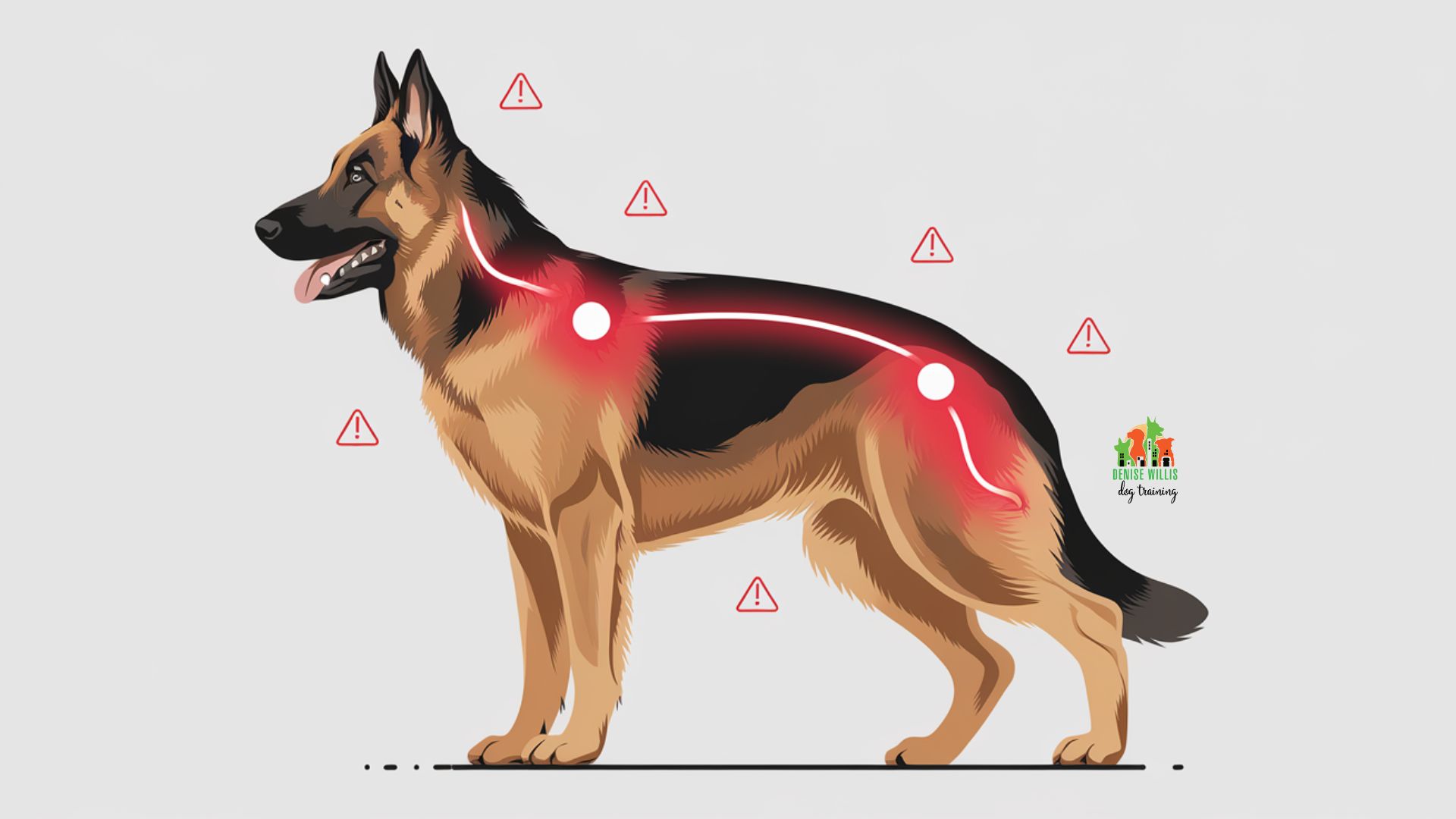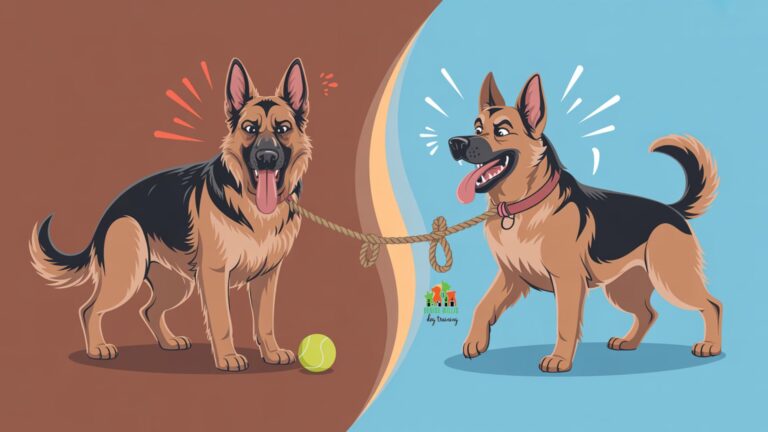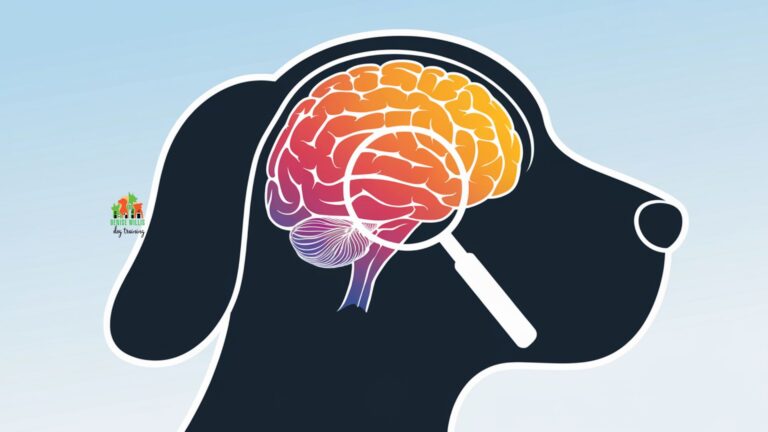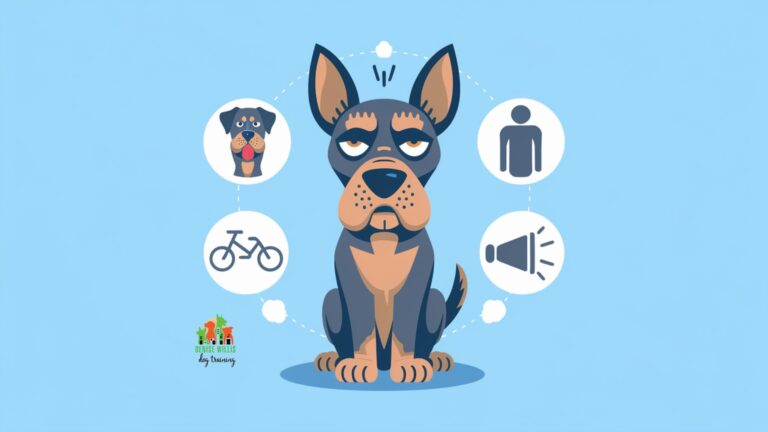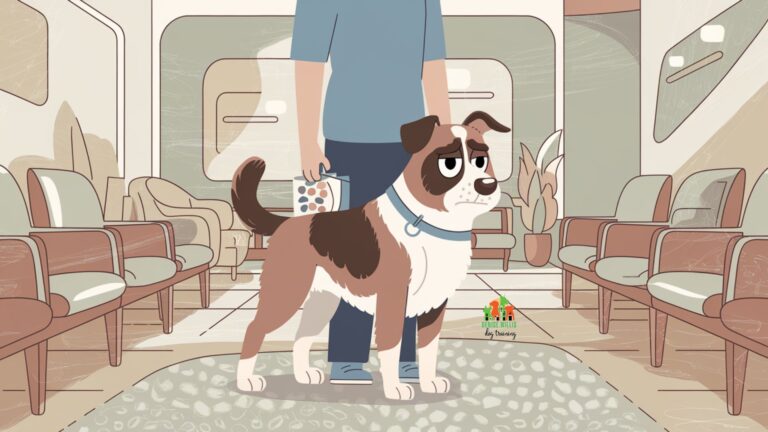Is Your Dog’s Aggression Caused by Pain? Signs to Look For and What to Do
📍 Service Area Notice: DW Dog Training provides in-person training services exclusively in the Greater Baltimore area. While our blog content is designed to help dog owners internationally, our hands-on training services are locally focused. For readers outside our service area, we hope you find value in our articles and welcome you to reach out with questions!
Remember when your sweet, tail-wagging bundle of joy would flop over for belly rubs faster than a teenager checking their phone?
Those were the days. Now your furry friend is doing their best impression of a grumpy bouncer at an exclusive club, complete with warning growls and “you can’t sit with us” attitude.
Before you start googling canine personality disorders or wondering if your dog is secretly plotting world domination, consider this: your pup might be pulling a classic case of “it’s not you, it’s me” – except in this case, it’s actually pain.
Pain-induced aggression in dogs is like that friend who becomes unreasonably cranky when they’re hungry, except instead of needing a snack, your dog needs medical attention. It’s a serious issue that transforms even the most easy-going pups into defensive warriors faster than you can say “veterinary emergency.”
And just like humans don’t love being poked when they’re hurting, dogs have their own way of saying “back off” – usually with more teeth and less subtle hints.
While some might blame it on your dog suddenly developing a taste for dramatic performances worthy of a soap opera, the reality is that pain changes everything. That loving pup who once welcomed belly rubs like they were winning lottery tickets might now bare teeth when approached, not because they’re auditioning for a role in “The Real Housedogs of Beverly Hills,” but because they’re genuinely hurting.
Key Takeaways
- Your dog isn’t staging a coup – sudden aggression often signals hidden pain
- Those growls might be your pup’s version of a medical alert system
- Professional help is crucial (no, watching dog training videos at 3 AM doesn’t count)
- Pain management usually turns Dr. Jekyll back into Mr. Hyde’s friendlier cousin
- Environmental tweaks can make your dog feel safer than a squirrel in a nut factory
Understanding Dog Pain-Induced Aggression
Warning Signs
Watch for sudden changes in behavior, avoiding touch, decreased activity, or unusual aggression when approached.
Age Factors
Different age groups show varied pain responses: puppies are dramatic, adults mask pain, seniors show obvious discomfort.
Treatment Options
Professional assessment, pain medication, physical therapy, and home modifications can help manage pain-induced aggression.
Emergency Response
Seek immediate veterinary care for sudden aggression, extreme lethargy, or significant mobility changes.
Age and Breed Considerations
Think of dogs like smartphones. Different models have different features, and they all act up differently when something’s wrong. Except instead of dealing with frozen screens and mysterious battery drains, we’re talking about various ways pain manifests across ages and breeds. Some dogs are like that friend who dramatically announces every paper cut, while others maintain a poker face worthy of a world championship even when dealing with serious discomfort.
The Puppy Chronicles
Puppies are basically the drama queens of the dog world – everything is either the BEST or the WORST thing ever. During those crucial growing months, they’re like teenagers going through growth spurts, except instead of raiding the fridge and sleeping until noon, they’re dealing with rapid bone development and potential joint issues.
Large breed puppies, particularly those destined to become gentle giants, need special attention during their growth spurts. It’s like watching a time-lapse video of a building being constructed – a lot can go wrong if the foundation isn’t properly supported. German Shepherds, Golden Retrievers, and Labs are especially prone to growing pains, with a whopping 40% chance of developing hip dysplasia. That’s higher odds than finding a matching sock pair in your laundry.
The Adult Dog Saga
Adult dogs are like that coworker who shows up to the office with the flu but insists they’re “totally fine.” They’re masters at masking pain, probably because they haven’t learned about the benefits of calling in sick and binge-watching Netflix. This stoic behavior means that by the time they’re showing signs of pain-induced aggression, they might have been dealing with discomfort longer than you’ve been putting off your New Year’s resolutions.
The Senior Citizen Scene
Senior dogs are the wise elders of the canine world, but even wisdom doesn’t make arthritis any more fun. These experienced souls often develop chronic conditions that make them grumpier than a cat in a rain shower.
The good news?
They’re usually more obvious about their discomfort than their younger counterparts, probably because they’ve reached the age where they just don’t care about maintaining a tough-guy image anymore.
Evolution of Understanding Dog Pain-Induced Aggression
Pre-2012: Early Observations
Veterinarians observed connections between pain and aggression but lacked systematic research. Understanding was based primarily on clinical observations and individual case studies.
March 2012: Landmark Study
Autonomous University of Barcelona published groundbreaking research examining 12 dogs with pain-induced aggression. Eight cases involved hip dysplasia, revealing distinct patterns in previously aggressive versus non-aggressive dogs.
December 2019: Comprehensive Review
Published review linked medical conditions to behavioral problems, identifying two key mechanisms: defensive reactions to avoid physical contact and stress-induced changes in brain serotonin levels.
2024: Current Focus
Emphasis on proactive diagnosis and early intervention strategies. Growing recognition of comprehensive veterinary examination for sudden behavioral changes, leading to improved treatment outcomes.
Professional Assessment Protocols
Getting to the bottom of pain-induced aggression requires more detective work than solving who really ate the last cookie from the break room. Unlike humans, who can dramatically point to what hurts (and maybe post about it on social media), dogs communicate through a complex system of behavioral changes that would challenge even Sherlock Holmes.
The Art of Canine Detective Work
Veterinarians have turned behavioral observation into something between a science and an art form. They’re like CSI investigators, except instead of analyzing crime scenes, they’re studying your dog’s every move, mood, and mealtime behavior. The standard eight-week trial period for pain medication assessment isn’t just arbitrary – it’s about as precisely timed as a master chef’s soufflé recipe.
Documentation becomes your new best friend during this process. Think of it as keeping a diary, except instead of writing about your crush, you’re noting whether Fido growled at the mailman or just gave them the stink eye. Every detail counts, from changed postures to modified daily routines, even increased sensitivity to your questionable taste in music.
What the Numbers Tell Us About Pain and Aggression
Think statistics are about as exciting as watching paint dry? Well, hold onto your spreadsheets, because these numbers tell a story more dramatic than your favorite Netflix series. We’ve collected data that would make even the most skeptical mathematician sit up and say “Who’s a good statistical analysis? Yes, you are!”
| Condition | Percentage | Notes | Source |
|---|---|---|---|
| Large Breed Hip Dysplasia | 40%+ | Affects Golden Retrievers, Labradors, and Rottweilers, leading to potential aggression | [1] |
| Pain-Related Aggression Study | 66.7% | Dogs showing aggression diagnosed with hip dysplasia | [1] |
| Senior Dog Cognitive Issues | 28% | Dogs 11-12 years old showing pain-related behavioral changes | [6] |
| Previously Non-Aggressive Dogs | 75% | Show increased aggression when experiencing chronic pain | [2] |
Look at those numbers and tell me your mind isn’t at least a little blown. It’s like finding out your quiet neighbor has been secretly training for ninja competitions. These statistics reveal the shocking truth about how many of our furry friends are silently dealing with pain-induced aggression. And that 40% hip dysplasia rate in large breeds?
That’s higher than the chances of picking the right checkout line at the grocery store on a Sunday afternoon.
If these numbers have you more worried than a cat in a room full of rocking chairs, don’t panic. Remember, knowledge is power – or in this case, the key to helping your four-legged friend feel better. Think of these statistics as your roadmap to understanding why your previously peaceful pup might be channeling their inner drama queen.
Now that we know what we’re dealing with, let’s talk about how to fix it.
Treatment Framework
Welcome to the world of canine pain management, where your dog might start getting more specialized care than a celebrity at a spa retreat. From traditional medications to alternative therapies, the options are more varied than flavors at an ice cream shop.
Medical Magic
Modern veterinary medicine pulls out all the stops faster than a Formula 1 pit crew. We’re talking NSAIDs for inflammation (fancy talk for “make the ouchy go away”), opioids for severe cases (the really good stuff), and physical therapy that might make your dog more flexible than your yoga instructor.
Alternative treatments have entered the chat too. Acupuncture might turn your skeptical pooch into a believer faster than you can say “needle phobia,” while laser therapy sounds like something from a sci-fi movie but actually helps reduce pain and inflammation. It’s like the future arrived, and it’s wearing a veterinary coat.
Home Sweet Home Modifications
Your house is about to get a makeover that would make any HGTV host proud. Think of it as “Extreme Home Makeover: Doggy Edition.” Non-slip flooring becomes your new obsession because watching your dog do an unintentional split on hardwood floors isn’t anyone’s idea of fun.
Strategic furniture placement creates safe zones that would impress a military tactician. Those throw rugs you’ve been hoarding? They’re about to become stepping stones in an elaborate network of safe passages for your furry friend. It’s like creating a doggy highway system, complete with rest stops (comfy beds) and scenic viewpoints (windows for squirrel watching).
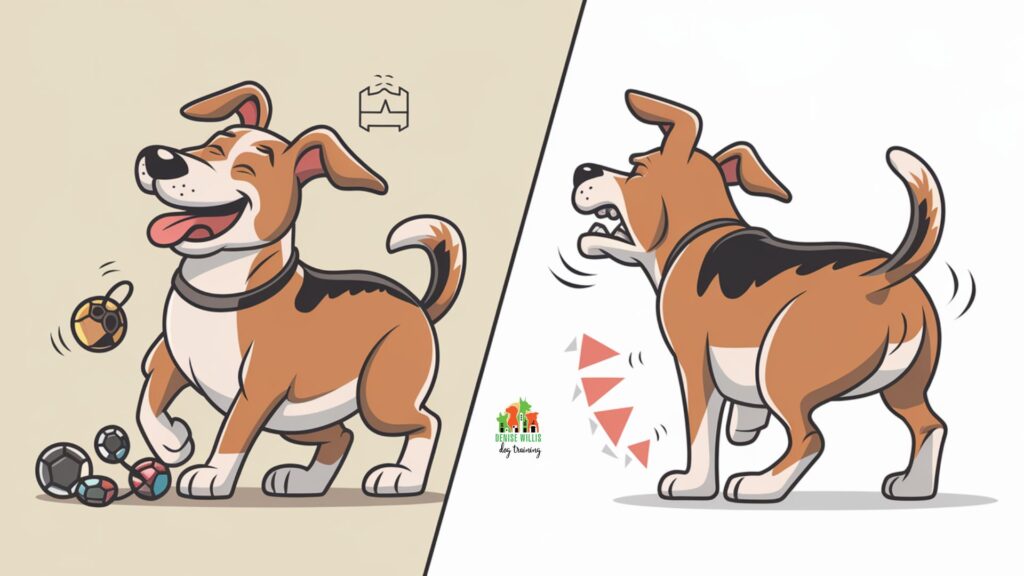
Emergency Response Protocol
Sometimes pain doesn’t politely knock on the door – it bursts in like your neighbor’s kid practicing their drum solo at 7 AM on a Sunday. Knowing when to hit the panic button (and when to just take a deep breath) can mean the difference between a routine vet visit and a starring role in your own medical drama.
Red Alert Scenarios
Certain situations deserve the same urgency as realizing you left your phone at a restaurant. Immediate veterinary attention becomes necessary when:
- Your normally peaceful pup suddenly channels their inner Cujo
- They’re doing their best impression of a statue (and not in a cute way)
- Walking becomes an interpretive dance performance
- They’re auditioning for a dramatic role in “Gone with the Wind” with excessive lethargy
Product Recommendations
When your dog is dealing with pain-induced aggression, finding the right tools becomes more important than a coffee maker on Monday morning. We’ve scoured the internet for the best products to help your hurting hound feel more comfortable than a cat in a sunbeam. From comfort to mobility, these gadgets might just turn your grumpy guardian back into a tail-wagging treasure.
- Big Barker 7″ Orthopedic Dog Bed: Finally, a bed that’s more supportive than your mom during college finals. This American-made orthopedic wonder comes with a 10-year “won’t flatten” guarantee and is clinically proven to reduce joint pain and improve mobility. It’s like a memory foam mattress had a baby with a cloud. Warning: Your dog may write you out of their will if you ever try to take this bed away.
- RUFFWEAR Web Master Dog Harness: The Swiss Army knife of support harnesses, complete with a handle that makes helping your mobility-challenged companion easier than ordering takeout. With three points of adjustment and extra padding, it’s like giving your dog a superhero suit that actually helps them fly. Warning: May cause your dog to strut around like they’re about to save the world.
- PetSafe Gentle Leader Head Collar: Transform walks from a tug-of-war championship into a peaceful stroll with this headcollar that gives you more control than a TV remote during sports season. Its padded noseband and quick-release safety feature make it both comfortable and secure. Warning: Your dog might start thinking they’ve joined an exclusive club where everyone wears sophisticated face accessories.
- Zuke’s Hip Action Dog Treats: These glucosamine-packed treats are like little edible magic wands for joint health. Made with real chicken and enriched with chondroitin, they’re the perfect mix of tasty and therapeutic. Your dog will think they’re getting away with something while actually doing their joints a favor. Warning: May cause excessive treat-related negotiations from your suddenly mathematical mutt.
- Outward Hound Puzzle Toy: Keep your pain-reactive pup mentally stimulated without physical strain. This interactive puzzle toy is like “Who Wants to Be a Millionaire” for dogs, except the prize is treats and the phone-a-friend option is pawing at you for hints. Warning: Your dog might start solving your crossword puzzles out of boredom.
Remember, while these products won’t turn your hurting hound into a pain-free puppy overnight, they’ll certainly make the journey more comfortable. Think of it as creating a spa experience for your four-legged friend – minus the cucumber slices and gossip magazines.
Who knows?
With the right combination of comfort and support, your dog might just forget they were ever auditioning for the role of neighborhood grump!
Further Reading
Think you’ve mastered the art of understanding pain-induced aggression? Well, hold onto your leash, because we’re about to take a deeper dive into the doggy psyche with these paw-some articles. Fair warning: Side effects may include becoming the neighborhood’s go-to dog whisperer and developing an uncanny ability to speak fluent canine.
- 10 Warning Signs Your Dog Might Bite and How to Prevent It: Think your dog’s just playing hard to get? This eye-opening guide reveals the subtle signals your pup’s been sending while you’ve been busy taking selfies with them. From the infamous “whale eye” to the less obvious “freeze frame,” you’ll learn to read your dog better than your favorite book. Spoiler alert: That cute yawning might not mean they’re tired of your jokes after all.
- Dog Aggression Solutions: A Complete Guide: Buckle up for a comprehensive journey through the world of canine conflicts and their solutions. This isn’t just another “sit, stay, good dog” tutorial – it’s your roadmap to understanding why your sweet angel occasionally acts like they’re auditioning for a horror movie. Plus, you’ll discover why “because I said so” works about as well on dogs as it did on you as a teenager.
- Decoding Your Dog: 15 Body Language Signals: Ever wish your dog came with subtitles? This guide is the next best thing! Learn to interpret everything from tail positions to ear angles, because your dog’s been trying to tell you things more complex than “ball” and “dinner.” Fair warning: You might start analyzing your own body language and realize you’ve been accidentally telling everyone at work you need a belly rub.
- How to Manage Your Dog’s Territorial Aggression: Is your dog trying to turn your home into Fort Knox? This article helps you negotiate peace treaties with your self-appointed security guard. From understanding why your dog thinks the mailman is planning a hostile takeover to learning how to convince them the neighbor’s cat isn’t a spy, this guide has it all. Bonus: Includes tips on explaining property laws to your furry friend in terms they’ll understand.
- Senior Dog Aggression Guide: When your golden oldie starts acting more like a grumpy old man than the neighborhood welcome wagon, this article has your back. Discover why age isn’t just a number when it comes to behavior changes, and learn how to help your senior citizen navigate their golden years with grace. This includes special sections on joint pain, cognitive changes, and why your dog might suddenly think its reflection is an intruder plotting world domination.
Ready to emerge from this reading marathon more enlightened than a Buddhist monk at a dog training seminar?
These articles will turn you into the dog psychology expert you never knew you wanted to be. Just remember: with great knowledge comes great responsibility… and probably the need for a bigger treat pouch.
Frequently Asked Questions
Q: Will my dog’s aggression disappear once the pain is treated?
A: Usually faster than your New Year’s resolutions! Most dogs return to their normal, lovable selves once pain is properly managed. However, like that one friend who holds a grudge about that time you forgot their birthday, some dogs might need additional behavioral support to fully recover their confidence.
Q: How can I tell if it’s pain or just bad behavior?
A: Look for the plot twist – sudden character changes in your furry friend’s behavior story usually point to pain. If your normally social butterfly suddenly acts like they’re auditioning for “The Grinch,” pain might be the uncredited director.
Q: Should I just wait it out and see if it gets better?
A: About as advisable as trying to teach a cat to fetch. Pain-induced aggression requires professional assessment faster than you can say “veterinary emergency.”
Q: Can I still pet my dog if they’re showing signs of pain-aggression?
A: Approach this like you would a coffee maker before it’s finished brewing – with extreme caution. Let your dog initiate contact, and always respect their space more than you respect your personal bubble at a crowded concert.
Test Your Knowledge: Pain-Induced Aggression in Dogs
Final Thoughts
Pain-induced aggression transforms our furry friends from loving companions into defensive warriors faster than you can say "veterinary emergency." But with proper recognition, professional help, and more patience than it takes to assemble IKEA furniture, you can help your dog return to their tail-wagging, face-licking, joy-spreading self.
Remember, DW Dog Training stands ready to support you and your four-legged friend through this challenging time. We're experts at helping dogs express their discomfort in ways that don't involve auditioning for "Jaws."
Share Your Experience
Has your dog's personality done a 180 due to pain?
Share your story below.
Maybe your experience will help another pet parent recognize the signs before their sweet pup starts practicing their impression of a guard dog at Fort Knox. Your triumph over pain-induced aggression might just be the lighthouse another dog owner needs to navigate these choppy waters.
Together, we can turn those growls back into tail wags, one pain-free pup at a time. Because at the end of the day, every dog deserves to feel as comfortable as a cat in a sunbeam, and every owner deserves to know why their best friend is acting more like a frenemy.

